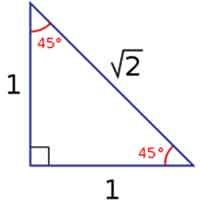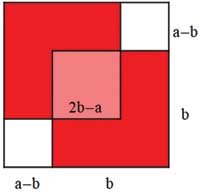R. Sivaraman
It is well-known that real numbers are comprised of both rational and irrational numbers. Though it is fairly easy to understand rational numbers (which are the quotient of two integers of the form say p/q where q is non-zero and p, q are relatively prime), the understanding of irrational numbers has been quite a nightmare for students as well as many others. The most interesting aspect of irrationals is that they are present throughout the number line and yet it is quite difficult to recognize them as precisely as their counterparts, the rational numbers.
History tells us that
is the first discovered irrational number. In particular, a disciple of Pythagoras, upon investigating numbers suddenly stumbled upon it, when he tried to determine the diagonal of an isosceles right triangle whose legs are of one unit length each.

This discovery led to the complete devastation of Pythagorean principles, which believed that everything in the universe is expressible through rational numbers. But here was a line segment of some particular length which was not equal to any of the known rational numbers. This became the first step in our understanding of irrational numbers. Often, one of the very first exercises for training in mathematics begins with the classic theorem proving that
is not rational. Here we see some versions of proving
as irrational. Using this as the template, we can prove that several classes of numbers are not rational numbers.
Proving irrationality
We begin our exploration by first showing
that is not rational.
Theorem 1
The number
is not rational.
First proof
We present the standard classical proof, which is quite well-known. We follow a method of proof called “Proof by Contradiction”, in which we assume the conclusion to be false and prove eventually that the hypothesis itself is false. Hence, if the hypothesis is true, then the conclusion must be true.
So, we start by assuming that
is a rational number say of the form
where p, q are
relatively prime and q is the smallest possible denominator (that is, it is in reduced form).
Now from
we get, 2p2=q2. Since q2 is even, q must be even. Otherwise, if q is odd, then from the equation 2p2=q2, we find that the left hand side is even, whereas the right hand side is odd, which is not possible. Hence, q must be even, say q=2s for some integer s. With this value of q, we have 2p2=q2=4s2 → p2=2s2. As above, p2 is even and so p must be even.
But wait, we have come to a situation where both p and q are even, contradicting the assumption that p and q are relatively prime. Moreover, since p is even, we have p=2r for some integer r. Also note that r<p, s<q. Hence from
we have
.
Note that we have written
as
where r<p, s<q contradicting the assumption that q is the smallest possible denominator in expressing
in the simplest rational form. Hence, these contradictions prove that
is not rational and so must be irrational.
Second proof
We now present the second proof by American logicist Stanley Tennenbaum. This proof will provide a visual representation of the required truth. As with the first proof, we assume that
is rational say
where a, b are integers. Since
>1, we see that a>b and b is the least possible denominator such that
.
Now from
we get a2=2b2. We try to construct a square of side length a as shown in Figure 2.

We see that in the whole square of side length a, there are two red squares of side length b which overlap forming a pink square of side length a – (a–b) – (a–b) = 2b–a as shown in Figure 2.
Since a2=2b2, the area of the two red squares of side length b, must be equal to the whole square whose side length is a. But according to Figure 2, we see that two red squares miss two smaller squares of side length a-b, but double count a square with side length 2b–a.
Consequently, the double counted region must have the same area as the two missing squares, that is, (2b–a)2=2(a–b)2 giving
. Also we observe that since a>b, 2b–a<a. Similarly, since 2b–a > 0, a–b < b. But this contradicts the fact that b is the smallest possible denominator in expressing
as a rational number. This contradiction thus proves that
is not rational.
We arrived at the same conclusion as in the first proof but this time presented it in visual form. There are at least half a dozen other proofs that can be adopted in showing that
is irrational. We now prove a more general theorem regarding identifying irrationals in square root radical forms.
Theorem 2
If a natural number n is not a perfect square, then
is not rational.
Proof
We adopt the same technique of Proof by Contradiction to show that
is irrational.
If possible, let
be rational of the form
, where a, b are relatively prime integers such that b is the smallest possible denominator in expressing
in such form.
Since a, b are relatively prime integers there exists integers x, y such that ax+by=1. Now from
we have
.
We now make the following manipulation:
Since, a, b, n, x, y are all integers it follows that bnx + ay is also an integer. Hence
must also be an integer implying that n is a perfect square, contrary to our assumption that n is not a perfect square. This contradiction proves that
is not rational.
Note:
Theorem 2 helps us generate infinitely many irrational numbers each of square root radical type.
We now prove a more general theorem regarding irrational numbers, but before doing that we provide the following known theorem (without proof) famously called as Fermat’s Last Theorem. This notorious theorem was proved by English Mathematician Andrew Wiles in 1995.
Theorem 3: (Fermat’s Last Theorem)
There do not exist natural numbers a, b, c, n such that an + bn = cn if n≥3.
However, in the words of the great French mathematician Fermat, who is the originator of this theorem, “Mathematicians have discovered truly marvelous proof of this, which this magazine is too narrow to contain”.
Using Fermat’s Last Theorem as stated in Theorem 3, we now prove the following theorem.
Theorem 4
The number is
not rational for any natural number n, such that n≥2.
Proof
If n=2, then =
is not rational by Theorem 1. Hence, we assume n≥3. As in the previous theorems, let us assume that
is rational and arrive at a contradiction.
Let
, where a, b are some natural numbers. Then an=2bn=bn+bn. Thus if
is a rational number, then the sum of two nth powers is another nth power, contradicting Fermat’s Last Theorem stated in Theorem 3. This contradiction proves that
is not rational.
Conclusion
In this article we not only proved that
is irrational but several class of numbers of the form
(n is not a perfect square) and
are irrationals using the same technique of Proof by Contradiction. This method is the finest weapon that is used by mathematicians to prove numerous theorems in most branches of mathematics.
The author is Associate Professor of Mathematics, D.G. Vaishnav College, Chennai. He has more than two decades of teaching experience. He has provided more than 300 lectures conveying the beauty and application of mathematics. He has written 20 books to popularize mathematics among the common man. He has won more than 30 awards for his distinguished service to mathematics. He can be reached at rsivaraman1729@yahoo.co.in.
